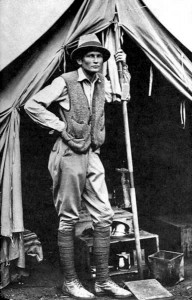22 November 2010
KUELAP–When Hiram Bingham became the first scientific  discoverer of Machu Pichu he and the world thought he had discovered the lost city of Vilcapampa, the last redoubt of the Incas where they retreated to under Manco Inca and fought a long and bitter guerilla war against the Spanish. Manco Inca was murdered by several renegade Spaniards and eventually, in 1572,  his descendent Tupac Amaru surrendered and was executed. With him died the Inca line and the last city of the Inca became the lost city of the Inca.
Machu Pichu, it turns out, was not the last and lost Inca city and was probably mostly abandoned before the Spaniards even arrived. In the years since Bingham discovered the most dramatic ancient city of the Americas many other Incan and pre-Incan cities have been found and several have aspired to the title of last-lost city. It turns out that Bingham actually discovered Vilcapampa not long after Machu Pichu but, at the time, did not realize its significance nor its size since it was heavily overgrown.
None of his actually relates to the fortress of Kuelap in the Chachapoyan region of Amazones other than it too was “lost” for a time and, had the Inca retreated to it, they might have held out longer since archeologists have no doubt that, in addition to domestic and sacred functions, Kuelap was very much a fortress.
While the Inca and even the Spaniards added pieces to the complex, Kuelap was, in fact, the crowning architectural achievement of the Chachapoyan people, a warrior culture that began somewhere around 750 A.D. and were conquered by the Incas shortly before the arrival of the Europeans.
Kuelap was to be the first of several sites we hiked to in the Chachapoyas region. We left about 0800 in a mini-van with a number of Catalonians who made sure to let everyone know they were not Spaniards and certainly not to be associated with the dastardly Castillians. The paved highway soon gave way to unpaved mountain roads without shoulder or rails. The edge of these gave way to spectacular views but vertigo-inducing and stomach churning drops from which the bus’s wheels were sometimes little more than a few inches.
Finally, above us, we could see some of the fort’s stonework along an overgrown ridge. We parked in an open field that dropped away into a deep canyon, bought tickets from a man in a shack and then proceeded to wait. Being American, and therefore impatient, we began to follow the clearly marked trail up towards the Chachapoyan redoubt. It was hot, over 90 degrees, dry and we were around 9,000 feet and climbing higher. We stopped to rest a couple times along the way and then, as we approached the main wall, Kristina began to feel light headed and nauseous. We stopped and drank water and sucked some boiled sweets that were supposed to help with altitude sickness and waited beneath the shade of some scrubby trees.
After a while Augosto, our flamboyant guide and the Catalonians caught up with us. Catching our breath a bit we entered Kuelap through the narrow main gateway. Much like Medieval European fortifications, the entrance was a choke-point, through which only a few men could pass at a time and from the top of which rocks and missiles could be rained down upon any attacker. Near the site’s highest point we went through another, even narrower defile and, to quote Augosto’s colorful explanation, “Here was point where enemies of Chachapoyan people would have to run. Chachapoyan warriors would throw down many stone axes and passageway would run with blood. If enemies of Chachapoyan people got through the passage Chachapoyans built a false platform out there on edge of cliff. If the enemies got through the narrow passage and ran out on it they fell into the abyss. And died.”
The site is still under excavation with archeological work underway even while we were there. As Kristina began to feel better I began to feel worse, developing a pounding headache. Augosto led us through the complex, explaining the different parts in detail, complete with historical asides such as, “You know Hernan Cortez, yes, who conquer Mexico? He and Pizarro are relatives. He tell Pizarro to leave bodies of dead Indians in water supply, is to spread the smallpox. You know where Pizarro is buried? He is buried in cathedral in Lima because Catholic church say if he buried there he is now in heaven with Jesus and the angels… Uh huh…”










One Comment